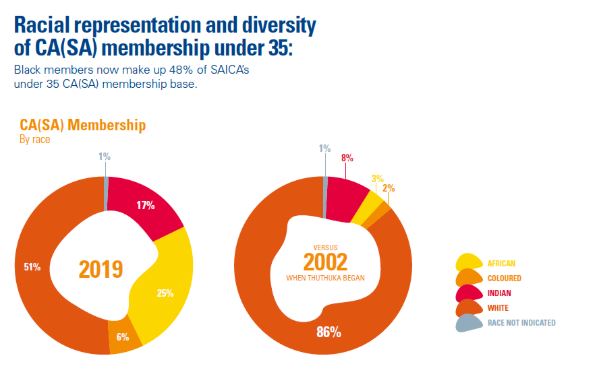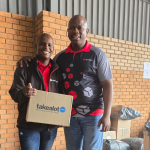Nelson Mandela is famously quoted in saying: “Education is the most powerful weapon which you can use to change the world.”
Yet how can we as a country speak about the skills sets required for the 21st century, when 90% of our schools do not have computers or internet access? How can we build new companies when our youngsters do not even have basic skills?
Indeed, EDUCATION – QUALITY EDUCATION – is the only solution that will lead to decent work for youth. It is also the key to eliminating gender inequality, reducing poverty, creating a sustainable planet, preventing needless deaths and illness, and fostering peace.
And while we as a country do have pockets of excellence, these are too small to serve our youngsters properly.
A brief look at the numbers explains the challenge South Africa faces in terms of providing sufficient and relevant educational opportunities:
South Africa’s 2019 matric pass rate of 81.3% does not tell the full story. It does not take into account the significant percentage of learners who drop out along the school journey.
For example, if you compare the matric pass rate to the number of children who entered grade 1 in 2008, you get a pass rate of 37.6% for the 2019 matric cohort. That is a terrifying number.
Education is and should be the top priority across sectors when it comes to developing South Africa’s future
So why do we view education as a short-term solution when the numbers show that there are a huge number of learners who started Grade 1 in 2008 who never finished their school education?
The biggest problem we as a society have today is distraction. In this day and age, we live for instant gratification. Immediate notifications, light-speed social media feeds, rapid internet connection… even our food is fast. There is no time to dawdle and get distracted, rather everything should happen the very instant we desire it.
The result?
While we tend to think of ourselves as efficient and competitive, instead of making real progress on the things that matter, we are simply putting a band-aid on a bullet wound. We are dealing with our education system in a similarly inadequate way. And, in doing so, we are watching the future of our country (and our continent) bleed out.
We are simply not digging deep enough nor are we spending enough time on the things we should be doing.
Education is the most critical investments we can make
Our failing education system is a matter of national concern.
While it is natural to blame much of this on the glaring inequalities still apparent in the education system 26 years into our democracy, bridging these shortcomings requires more than government intervention: it takes patience as well as cooperation and support of all the role players in the broader national economy.
It would be easy to play the national education blame game and say that the government should find ways to solve the problem. But the truth is that, because quality education is the country’s most powerful instrument for reducing poverty and improving the economy it is the responsibility of all stakeholders to ‘put the economy back on a growth path’ by focusing on improving our education outcomes.
This is, however, not a project that we can or should rush.
Public-private partnership is crucial to addressing South Africa’s education challenges
By creating synergies that leverage the talents, expertise and powers of all stakeholders involved, partnerships create a catalytic force capable of resolving infrastructure gaps. In education these gaps include among others:
- The quality of the education system;
- The shortage of skilled educators;
- A lack of leadership.
It is a huge undertaking. But it can be done. An example of a public-private partnership achieving great success in the education area is the South African Institute of Chartered Accountants’ (SAICA) Thuthuka model.
17 years of successful education momentum
Built on partnerships between government, the profession, commerce and industry, academia and individuals, SAICA’s Thuthuka model illustrates the power of these synergies.
At school-level, Thuthuka provides learners and teachers with mathematics and responsible leadership programmes.
When it started in 2002, we operated in only one province. Today, public-private partnerships make it possible for the Thuthuka Education Upliftment Fund to run in excess of 40 annual programmes across the country.
Our impact?
Since inception, we have reached over 1 million learners.
Going one step further, Thuthuka also works closely with tertiary institutions to address educational inequalities by building additional capacity at all of South Africa’s Historically Disadvantaged Institutions (HDIs). This is crucial as our HDIs, whose mission it is to serve the disadvantaged, still remain critically under-funded and under-resourced.
For students, the benefits of HDI accreditation extend beyond the obvious. By making education of this quality available at multiple locations throughout the country, often outside major centres, the necessity for students to travel to distant towns or cities is alleviated. This means more students have the benefit of staying close to their families while studying. Thus the inevitable stress which accompanies the jump from high school to university is mitigated.
It is with the benefit of nearby family support that students will have the best possible chance of academic success. By raising the calibre of education available in their home towns, students are also less likely to relocate. Instead, they use their knowledge and experience to contribute to the economy of the local area.
This too is not a quick-fix solution. It takes an HDI anywhere between five and seven years of hard work, collaboration and servant leadership to gain SAICA accreditation for its BCom CA-stream degree. SAICA’s recent accreditation of the University of Venda means all six of SA’s HDIs now offer a SAICA accredited undergraduate BCom CA-stream Accounting degree.
Thuthuka also identifies the most gifted maths learners so that they can apply for a Thuthuka Bursary. The Thuthuka Bursary Fund is strategically positioned as part of a solution to the nation’s skills development transformation needs. It gives disadvantaged African and Coloured learners the opportunity to study at one of the country’s 12 SAICA-accredited universities that run a Thuthuka programme, assisting these students to become chartered accountants (CAs[SA]).
Unlike most bursary programmes, which only focus on one area – funding – Thuthuka offers students full wrap-around support to improve student success. Research has shown that no matter how academically capable, students from the poor and working-class demographic do not fare well in their tertiary studies without support in both the academic and non-academic areas. Funding alone is not sufficient. Issues such as social and psychological support are just as critical in ensuring that these students are able to cope with the demand and pace of tertiary institutions as these students often lag behind due to an inability to acclimatise quickly enough to the new pace and environments they find themselves in.
In mitigating many of the risks associated with South Africa’s high university drop-out rates, Thuthuka’s full wrap-around support makes our students more successful than their counterparts. It is also this approach that makes Thuthuka students ready to face the challenges of the workplace.
Have we been successful?
Since 2005, Thuthuka has supported over 3 000 aspiring CAs(SA) with excellent results:
- Over 1 400 have qualified as CAs(SA)
- while more than 2 000 prospective CAs(SA) are in various stages of our qualification process
Viewed with the knowledge that the CA(SA) qualifying process takes a minimum of seven years, we are therefore incredibly proud to reveal that our membership for members under 35 has gone from 3% African and 2% coloured to 25% African and 6% coloured respectively – all with the help of Thuthuka.

But we are not there yet.
As business, we need to move away from projects of self-importance to those of national importance.
We need to consciously work together to fix our education system at all levels – from early childhood development to secondary and tertiary training – with particular focus on occupations in high demand, be they delivered by universities or TVET Colleges. We need to improve the quality of education we are providing to our youngsters and capacitate our schools and lecturers with the best teaching staff.
We need to be generous with our knowledge and skills.
It is for this reason that, in 2016, SAICA took its transformation agenda one step further. We invested our expertise to assist in crafting and launching a sustainable funding structure solution for higher education using our internationally respected Thuthuka model. That solution, the Ikusasa Student Financial Aid Programme (ISFAP), piloted in 2017 and is currently fast-tracking South Africa’s production of scarce skills for the 21st century by funding over 1 700 students studying towards 12 occupations of high demand (OHDs). By increasing the number of students studying towards STEM (Science, Technology, Engineering and Maths) qualifications, the ISFAP model focuses on creating employable graduates who can become active participants in the economy.
Success stories such as Thuthuka create a compelling argument for how public-private partnerships can help the government. And while it’s an ambitious target, our aim is to one day ensure that not one single child is lost in the system.
Improvement in the quality of and accessibility to education is at the core of economic growth and social stability
Bridging these shortcomings requires more than government intervention: it takes the cooperation and support of all the role players in the broader national economy.
To address the problem of skills development we need programmes to pool together a coalition of activists who collectively acknowledge the role we have to play in fixing the system.
But, it is not enough merely to provide SA’s youth with the opportunity to gain a tertiary qualification. To overcome the stumbling blocks described by the National Development Plan, we must expand their potential sources of sustainable employment too.
In South Africa, a lack of experience and work-readiness has given rise to the large number of graduates who remain unemployed post-qualification. Indeed, many corporates avoid employing newly qualified graduates as they do not have the practical experience they need to enter the working world.
As business we need to create a new way of thinking in which we do not drop the standards of entry, but raise the bar from school to post-graduate learnerships so that our youth can gain sustainable and meaningful employment.
SAICA has proudly heeded the call for private and public sectors, as well as civil society, to rally behind a united vision. We urge all businesses to do the same. By collaborating and playing our part in prioritising education across all sectors, together we can change South Africa’s future. DM


















 Become an Insider
Become an Insider